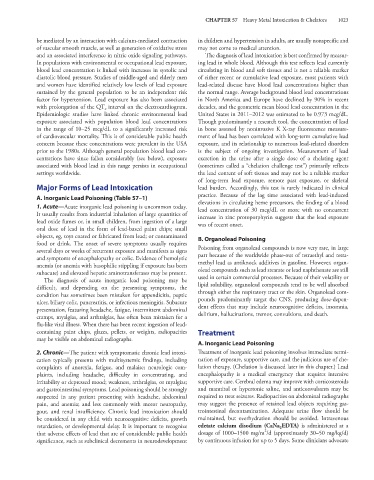Page 1037 - Basic _ Clinical Pharmacology ( PDFDrive )
P. 1037
CHAPTER 57 Heavy Metal Intoxication & Chelators 1023
be mediated by an interaction with calcium-mediated contraction in children and hypertension in adults, are usually nonspecific and
of vascular smooth muscle, as well as generation of oxidative stress may not come to medical attention.
and an associated interference in nitric oxide signaling pathways. The diagnosis of lead intoxication is best confirmed by measur-
In populations with environmental or occupational lead exposure, ing lead in whole blood. Although this test reflects lead currently
blood lead concentration is linked with increases in systolic and circulating in blood and soft tissues and is not a reliable marker
diastolic blood pressure. Studies of middle-aged and elderly men of either recent or cumulative lead exposure, most patients with
and women have identified relatively low levels of lead exposure lead-related disease have blood lead concentrations higher than
sustained by the general population to be an independent risk the normal range. Average background blood lead concentrations
factor for hypertension. Lead exposure has also been associated in North America and Europe have declined by 90% in recent
with prolongation of the QT interval on the electrocardiogram. decades, and the geometric mean blood lead concentration in the
c
Epidemiologic studies have linked chronic environmental lead United States in 2011–2012 was estimated to be 0.973 mcg/dL.
exposure associated with population blood lead concentrations Though predominantly a research tool, the concentration of lead
in the range of 10–25 mcg/dL to a significantly increased risk in bone assessed by noninvasive K X-ray fluorescence measure-
of cardiovascular mortality. This is of considerable public health ment of lead has been correlated with long-term cumulative lead
concern because these concentrations were prevalent in the USA exposure, and its relationship to numerous lead-related disorders
prior to the 1980s. Although general population blood lead con- is the subject of ongoing investigation. Measurement of lead
centrations have since fallen considerably (see below), exposure excretion in the urine after a single dose of a chelating agent
associated with blood lead in this range persists in occupational (sometimes called a “chelation challenge test”) primarily reflects
settings worldwide. the lead content of soft tissues and may not be a reliable marker
of long-term lead exposure, remote past exposure, or skeletal
Major Forms of Lead Intoxication lead burden. Accordingly, this test is rarely indicated in clinical
A. Inorganic Lead Poisoning (Table 57–1) practice. Because of the lag time associated with lead-induced
elevations in circulating heme precursors, the finding of a blood
1. Acute—Acute inorganic lead poisoning is uncommon today. lead concentration of 30 mcg/dL or more with no concurrent
It usually results from industrial inhalation of large quantities of increase in zinc protoporphyrin suggests that the lead exposure
lead oxide fumes or, in small children, from ingestion of a large was of recent onset.
oral dose of lead in the form of lead-based paint chips; small
objects, eg, toys coated or fabricated from lead; or contaminated B. Organolead Poisoning
food or drink. The onset of severe symptoms usually requires
several days or weeks of recurrent exposure and manifests as signs Poisoning from organolead compounds is now very rare, in large
and symptoms of encephalopathy or colic. Evidence of hemolytic part because of the worldwide phase-out of tetraethyl and tetra-
anemia (or anemia with basophilic stippling if exposure has been methyl lead as antiknock additives in gasoline. However, organ-
subacute) and elevated hepatic aminotransferases may be present. olead compounds such as lead stearate or lead naphthenate are still
The diagnosis of acute inorganic lead poisoning may be used in certain commercial processes. Because of their volatility or
difficult, and depending on the presenting symptoms, the lipid solubility, organolead compounds tend to be well absorbed
condition has sometimes been mistaken for appendicitis, peptic through either the respiratory tract or the skin. Organolead com-
ulcer, biliary colic, pancreatitis, or infectious meningitis. Subacute pounds predominantly target the CNS, producing dose-depen-
presentation, featuring headache, fatigue, intermittent abdominal dent effects that may include neurocognitive deficits, insomnia,
cramps, myalgias, and arthralgias, has often been mistaken for a delirium, hallucinations, tremor, convulsions, and death.
flu-like viral illness. When there has been recent ingestion of lead-
containing paint chips, glazes, pellets, or weights, radiopacities Treatment
may be visible on abdominal radiographs.
A. Inorganic Lead Poisoning
2. Chronic—The patient with symptomatic chronic lead intoxi- Treatment of inorganic lead poisoning involves immediate termi-
cation typically presents with multisystemic findings, including nation of exposure, supportive care, and the judicious use of che-
complaints of anorexia, fatigue, and malaise; neurologic com- lation therapy. (Chelation is discussed later in this chapter.) Lead
plaints, including headache, difficulty in concentrating, and encephalopathy is a medical emergency that requires intensive
irritability or depressed mood; weakness, arthralgias, or myalgias; supportive care. Cerebral edema may improve with corticosteroids
and gastrointestinal symptoms. Lead poisoning should be strongly and mannitol or hypertonic saline, and anticonvulsants may be
suspected in any patient presenting with headache, abdominal required to treat seizures. Radiopacities on abdominal radiographs
pain, and anemia; and less commonly with motor neuropathy, may suggest the presence of retained lead objects requiring gas-
gout, and renal insufficiency. Chronic lead intoxication should trointestinal decontamination. Adequate urine flow should be
be considered in any child with neurocognitive deficits, growth maintained, but overhydration should be avoided. Intravenous
retardation, or developmental delay. It is important to recognize edetate calcium disodium (CaNa EDTA) is administered at a
2
2
that adverse effects of lead that are of considerable public health dosage of 1000–1500 mg/m /d (approximately 30–50 mg/kg/d)
significance, such as subclinical decrements in neurodevelopment by continuous infusion for up to 5 days. Some clinicians advocate

